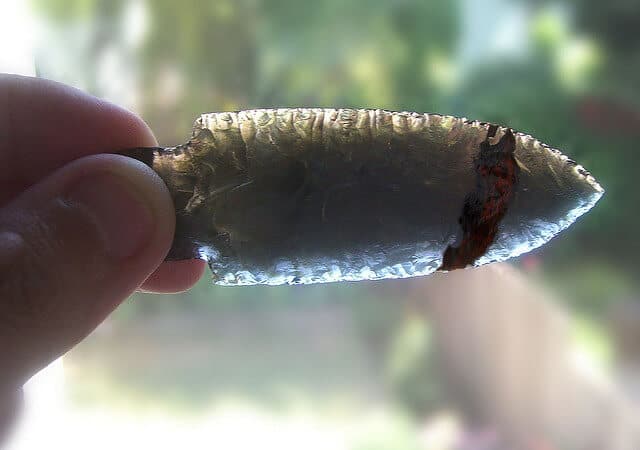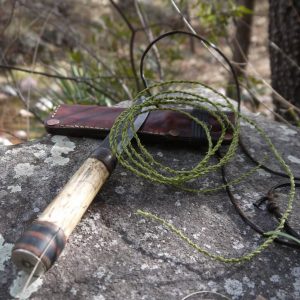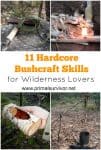There is nothing like going into the wilderness with a few basic supplies and your own wits. I know that I’m not alone in this thought. There’s recently been a huge surge in people learning bushcraft skills.
The great thing about the bushcraft community is that they aren’t snobs. There isn’t any of that “your gear is too heavy” of the lightweight backpacker community, or any of the “you’re too slow” snobbery that pervades the thru-hiker community.
In short, bushcraft is a way to enjoy nature without feeling pressure that there is a “right” or a “wrong” way of doing it. (If you are doing it wrong, you’ll know it when you have to head home early because you are freezing and starving! ;))
I particularly love how bushcraft survivalists are eager to share their skills without trying to make newbie members of the community feel stupid.
Be sure to read up about the essential bushcraft tools and the best bushcraft backpack before you get started.
Here are just some of the more hardcore bushcraft skills you can try. Don’t worry if you don’t get them on the first try. You’ll have fun trying, I promise!
Featherstick

Fire is essential for survival in the wilderness. You need fire to:
- Boil water for purifying water
- Cooking food
- Staying warm
- Warding away animals
I admit that I usually bring a firestarter (Amazon link) along with me when I go camping. A bit of toilet paper works great. Or, if I really planned ahead, I rub some Vaseline on cotton balls. It lights up in a second and burns for a long time.
But what if you don’t have a firestarter? Making a featherstick is a great way to get a fire going – especially if you are trying to make a fire in wet conditions.
Making feathersticks is actually pretty fun and fairly mindless. So you can do it while sitting around camp.
Learn how to make a featherstick in this video by King Bushcraft.
Flintknapping

Flintknapping is the ancient survival skill of being able to break rocks into tools. In this picture, it is a chunk of obsidian that has been knapped into a spear.
Like most other bushcraft skills, flintknapping does take patience. It takes a steady hand and a lot of control. You’ll end up with a lot of cuts and blisters on your hands before you master the art.
But the result will be a beautiful, homemade spear or knife that you can use in the wilderness.
Making Rope from Plants

Rope is another one of those essential survival gear you need for tasks like making a shelter, making animal traps, or just fixing your bootlace.
What if you didn’t bring any paracord in your bushcraft kit? Just make some!
This rope is made from twisted yucca. Yeah, it does take a lot of patience to make strong rope but you’ll be glad you know how if you find yourself in a survival situation.
Pot Hanger

A lot of bushcraft explorers bring a portable stove with them. This is perfectly fine. But there is nothing like cooking food directly over the fire! To do this, you are going to need a way of getting your pot over the flames.
That’s where this bushcraft skill comes in. There are a bunch of ways to make a pot hanger – some much more complicated than others.
You can also keep it simple and notch branches, as was done in this picture.
Related: Best Bushcraft Axe
Homemade Alcohol Stove

It really sucks that you can’t easily find unspoiled nature anymore. Wherever you go, there always seems to be some trash around.
But this trash can work in your favor – so long as you know how to utilize it properly.
Take this homemade bushcraft stove as an example. It was made from:
- 2 cans
- Cotton wick (Amazon Link)
- Stone to hold the lid on
- Clamp for a handle
- License plate for a windscreen
- Tiny cup holding alcohol fuel inside
This simple design will boil minestrone soup in just 15 minutes!
Primitive Trap

In all honesty, you’ll probably be eating insects in a survival situation. They are the easiest to find and full of nutrients (some actually taste good too).
Yet, hardcore survivalists will know the bushcraft skill of making snares and traps.
One of the simplest and most effective traps is the deadfall trap.
Learn 5 ridiculously simple animal traps here.
Making a Bark Container
This is definitely a hardcore bushcraft skill. Let’s say that you are in the wilderness and don’t have a pot or canteen. Obviously, this is going to make some problems. You need a container for tasks like:
- Boiling water
- Storing water
- Cooking food
Don’t worry – you can make a primitive container using birch bark. Other types of bark also work, but birch is the easiest to get off the tree.
See more ways to boil water without a pot.
Rock-Boiling Water

Now that you’ve made a bark container, you can use it to boil water.
How?
You heat rocks in a fire. Then you put the rocks into the bark container. The heat from the rocks will cause the water in it to boil.
You’ll have to keep on adding rocks to the water so it stays boiling. As I said, bushcraft skills require patience!
Cooking Meat

Here’s a simple bushcraft skill: cooking meat over the fire. You’d be surprised how many people try to complicate this task by making skewers or roasting sticks. I personally prefer this hands-off approach.
Bow Drill Fire-Starting Method

There are lots of ways to start a fire without matches or a lighter. Rubbing two sticks together is NOT one of them!
Instead of wasting your time rubbing sticks, make a bow drill. This method allows you to get maximum friction while sparing your hands.
You can learn more ways to start a fire without matches here.
Shelter Building

And, of course, every good survivalist knows how to make a shelter in the wilderness. This is just one beautiful example of a bushcraft shelter.
See more wilderness survival shelter designs here.
What bushcraft skills are you learning?
“Twisted yucca fiber cordage” (CC BY-NC-ND 2.0) by dog.breath
“IMGP1227” (CC BY 2.0) by ProAdventure
“Bushcraft: Home-made Alcohol Stove” (CC BY-NC-ND 2.0) by Baha’i Views / Flitzy Phoebie
“figure-4-deadfall-at-alderleaf-wildernes” (CC BY-NC-ND 2.0) by Alderleaf Wilderness College
“rock-boiling-at-alderleaf-wilderness-col” (CC BY-NC-ND 2.0) by Alderleaf Wilderness College
“Survival 02” (CC BY 2.0) by ProAdventure
“I smell smoke” (CC BY-NC-ND 2.0) by dog.breath




MONSTER!!!!!!! Excellent article. There are people who like to go out to the field with the whole team, but it is not comfortable. I prefer austerity, making tools, little equipment and a lot of silence !!!! Huge hug from Argentina !!!!!
Glad to have an international reader here. I’m sure your bushcraft knowledge looks a lot different than mine in the deciduous northern hemisphere 🙂
yeah it the best
WOW that was excellent!!!!!! I’m a survivalist myself!!!!
Great way to learn flint knapping is to use the bottoms of glass beer/soda bottles. Much easier to work than stone, but gives good (and cheap) insight into how cracks/chips form and break.
Great tip.
Take a second and check out the link on the pot hangers. That’s intense. I guess everyone needs something to do around the campfire at night. I generally just go with a couple feet of light chain and an S hook. The hanging length is widely variable and it packs down to virtually nothing. It’s kind of strange to think about, but if you read English, Norse or Celtic mythologies and histories some of the most stolen/plundered things were tripods and kettles. Tripods of course are the three metal legs used to hang a kettle over a fire. It gives an idea of how valuable a good cooking set up can be when you’re living outside and pretty close to the bone.
The birch container was neat. One mite be able to place glue gathered from a ?fir tree? on the inside and maybe water could be placed inside a larger one? One can also make rope from the inside bark of a branch from a tree. Two strands do not have to be braided to be used in an emergency situation, Just tie the ends together and the more loops the longer the rope if you need to swing a rope out to a person hugging a rock in a river or that has fallen down a cliff. It is also best for raft making where it can be fitted into grooves of larger branches or logs.
Pine resin should work. Also great tips on the rope making. Thanks
If my troops would have built that shelter, Flunk.
what troops are you referring to,
To make a negative comment based on one long range photo and not including Your credentials is rather harsh. Not cool hombre
He´s propably reffering to the height of the shelter as (at least in my country´s forces) the hight must not excede the hight of your knees.
He may be using the shelter structure also as a wind block to keep his fire burning. In that case it needs to be higher than knee level. The angle of the pic may throw off the scale/height of the structure as well.
Maybe it was just temporary and someone took a quick pic. Instead of criticizing, be glad someone actually got outside to do something even you enjoy.